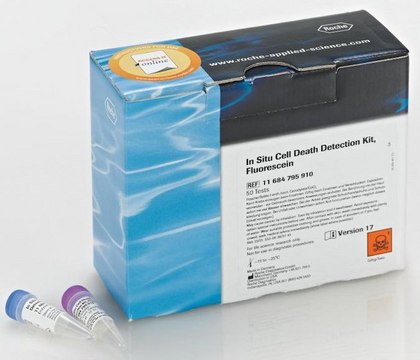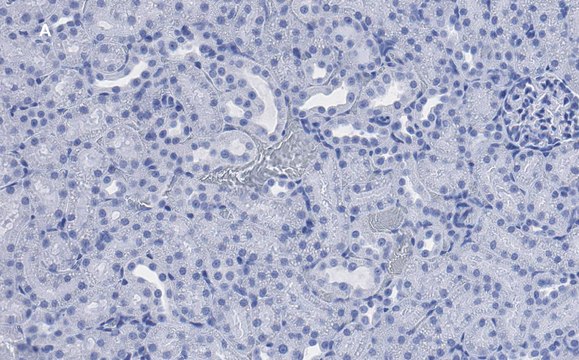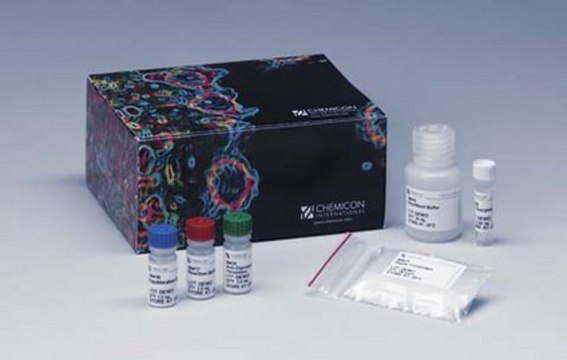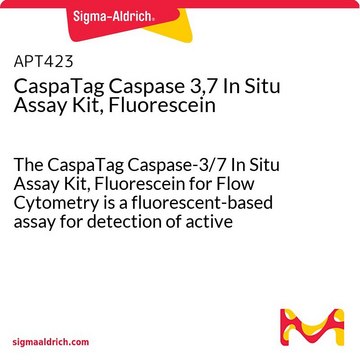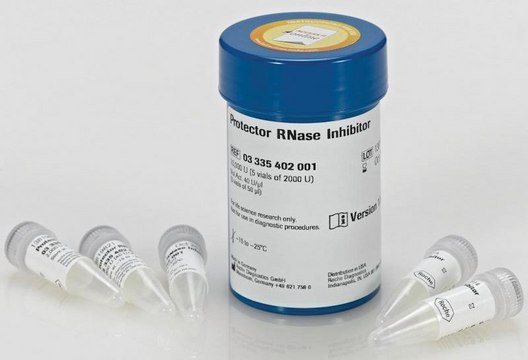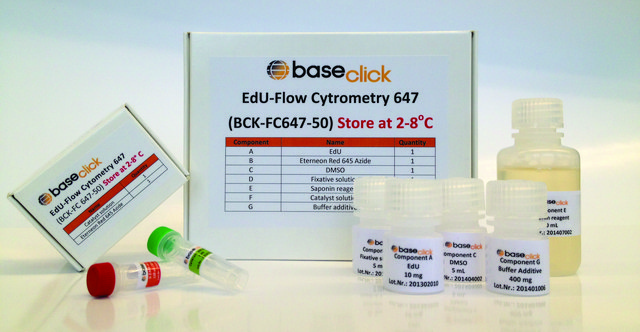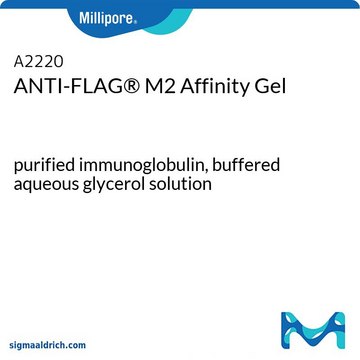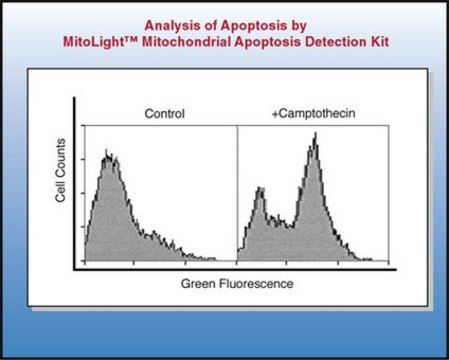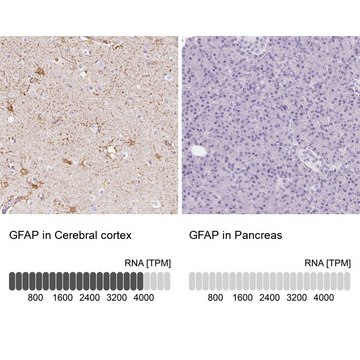推荐产品
质量水平
种属反应性(根据同源性预测)
mammals
制造商/商品名称
CaspaTag
Chemicon®
技术
activity assay: suitable
flow cytometry: suitable
检测方法
fluorometric
运输
wet ice
一般描述
Apoptosis is an evolutionarily conserved form of cell suicide, which follows a specialized cellular process. The central component of this process is a cascade of proteolytic enzymes called caspases. These enzymes participate in a series of reactions that are triggered in response to pro-apoptotic signals and result in the cleavage of protein substrates, causing the disassembly of the cell (Slee et al. 1999).
Caspases have been identified in organisms ranging from C. elegans to humans. The mammalian caspases play distinct roles in apoptosis and inflammation. In apoptosis, caspases are responsible for proteolytic cleavages that lead to cell disassembly (effector caspases), and are involved in upstream regulatory events (initiator caspases). An active caspase consists of two large and two small subunits that form two heterodimers which associate in a tetramer (Walker et al. 1994; Wilson et al. 1994; Rotonda et al. 1996). In common with other proteases, caspases are synthesized as precursors that undergo proteolytic maturation, either autocatalytically or in a cascade by enzymes with similar specificity (Kumar 1999).
Caspase enzymes specifically recognize a 4 or 5 amino acid sequence on the target substrate which necessarily includes an aspartic acid residue. This residue is the target for cleavage, which occurs at the carbonyl end of the aspartic acid residue (Thornberry et al. 1997). Caspases can be detected via immunoprecipitation, immunoblotting techniques using caspase specific antibodies, or by employing fluorochrome substrates which become fluorescent upon cleavage by the caspase.
Test Principle:
CHEMICON′s In Situ Caspase Detection Kits use a novel approach to detect active caspases. The methodology is based on Fluorochrome Inhibitors of Caspases (FLICA). The inhibitors are cell permeable and non-cytotoxic. Once inside the cell, the inhibitor binds covalently to the active caspase (Ekert et al. 1999). This kit uses a carboxyfluorescein-labeled fluoromethyl ketone peptide inhibitor of caspase (FAM-VAD-FMK), which produces a green fluorescence. When added to a population of cells, the FAM-VAD-FMK probe enters each cell and covalently binds to a reactive cysteine residue that resides on the large subunit of the active caspase heterodimer, thereby inhibiting further enzymatic activity. The bound labeled reagent is retained within the cell, while any unbound reagent will diffuse out of the cell and is washed away. The green fluorescent signal is a direct measure of the amount of active caspase present in the cell at the time the reagent was added. Cells that contain the bound labeled reagent can be analyzed by 96-well plate-based fluorometry, fluorescence microscopy, or flow cytometry.
Application:
The CHEMICON In Situ FLICA Pan-Caspase Detection Kit is a fluorescent-based assay for detection of active caspases in cells undergoing apoptosis. The kit is for research use only. Not for use in diagnostic or therapeutic procedures.
Caspases have been identified in organisms ranging from C. elegans to humans. The mammalian caspases play distinct roles in apoptosis and inflammation. In apoptosis, caspases are responsible for proteolytic cleavages that lead to cell disassembly (effector caspases), and are involved in upstream regulatory events (initiator caspases). An active caspase consists of two large and two small subunits that form two heterodimers which associate in a tetramer (Walker et al. 1994; Wilson et al. 1994; Rotonda et al. 1996). In common with other proteases, caspases are synthesized as precursors that undergo proteolytic maturation, either autocatalytically or in a cascade by enzymes with similar specificity (Kumar 1999).
Caspase enzymes specifically recognize a 4 or 5 amino acid sequence on the target substrate which necessarily includes an aspartic acid residue. This residue is the target for cleavage, which occurs at the carbonyl end of the aspartic acid residue (Thornberry et al. 1997). Caspases can be detected via immunoprecipitation, immunoblotting techniques using caspase specific antibodies, or by employing fluorochrome substrates which become fluorescent upon cleavage by the caspase.
Test Principle:
CHEMICON′s In Situ Caspase Detection Kits use a novel approach to detect active caspases. The methodology is based on Fluorochrome Inhibitors of Caspases (FLICA). The inhibitors are cell permeable and non-cytotoxic. Once inside the cell, the inhibitor binds covalently to the active caspase (Ekert et al. 1999). This kit uses a carboxyfluorescein-labeled fluoromethyl ketone peptide inhibitor of caspase (FAM-VAD-FMK), which produces a green fluorescence. When added to a population of cells, the FAM-VAD-FMK probe enters each cell and covalently binds to a reactive cysteine residue that resides on the large subunit of the active caspase heterodimer, thereby inhibiting further enzymatic activity. The bound labeled reagent is retained within the cell, while any unbound reagent will diffuse out of the cell and is washed away. The green fluorescent signal is a direct measure of the amount of active caspase present in the cell at the time the reagent was added. Cells that contain the bound labeled reagent can be analyzed by 96-well plate-based fluorometry, fluorescence microscopy, or flow cytometry.
Application:
The CHEMICON In Situ FLICA Pan-Caspase Detection Kit is a fluorescent-based assay for detection of active caspases in cells undergoing apoptosis. The kit is for research use only. Not for use in diagnostic or therapeutic procedures.
应用
Research Category
Apoptosis & Cancer
Apoptosis & Cancer
The In Situ FLICA Pan-Caspase Detection Kit for flow cytometry is a fluorescent-based assay for detection of active caspases in cells undergoing apoptosis.
组分
FLICA Reagent (FAM-VAD-FMK): Four lyophilized vials
10X Wash Buffer: 60 mL
Fixative (10% formaldehyde): 6 mL
Propidium Iodide: 1 mL at 250 μg/mL, ready-to-use
Hoechst Stain: 1 mL at 200 μg/mL, ready-to-use
10X Wash Buffer: 60 mL
Fixative (10% formaldehyde): 6 mL
Propidium Iodide: 1 mL at 250 μg/mL, ready-to-use
Hoechst Stain: 1 mL at 200 μg/mL, ready-to-use
储存及稳定性
· Store unopened kit materials at 2-8°C up to their expiration date.
· Reconstituted FLICA Reagent (150X) should be frozen at -20ºC for up to 6 months, and may be thawed twice during this time. Aliquot into separate amber tubes if desired. Protect from light at all times.
· Store diluted (1X) wash buffer up to -20ºC for 2 weeks.
· Reconstituted FLICA Reagent (150X) should be frozen at -20ºC for up to 6 months, and may be thawed twice during this time. Aliquot into separate amber tubes if desired. Protect from light at all times.
· Store diluted (1X) wash buffer up to -20ºC for 2 weeks.
法律信息
CHEMICON is a registered trademark of Merck KGaA, Darmstadt, Germany
免责声明
Unless otherwise stated in our catalog or other company documentation accompanying the product(s), our products are intended for research use only and are not to be used for any other purpose, which includes but is not limited to, unauthorized commercial uses, in vitro diagnostic uses, ex vivo or in vivo therapeutic uses or any type of consumption or application to humans or animals.
警示用语:
Danger
危险分类
Acute Tox. 3 Inhalation - Acute Tox. 4 Dermal - Acute Tox. 4 Oral - Carc. 1B - Eye Irrit. 2 - Muta. 2 - Skin Irrit. 2 - Skin Sens. 1 - STOT SE 2 - STOT SE 3
靶器官
Eyes,Central nervous system, Respiratory system
储存分类代码
6.1C - Combustible acute toxic Cat.3 / toxic compounds or compounds which causing chronic effects
法规信息
新产品
N Rökaeus et al.
Oncogene, 26(7), 982-992 (2006-08-16)
We have previously identified PRIMA-1, a low molecular weight compound that restores the transcriptional transactivation function to mutant p53 and induction of apoptosis. To explore the molecular mechanism for PRIMA-1-induced mutant p53-dependent apoptosis, we examined the intracellular distribution of mutant
Wei-June Chen et al.
The Journal of experimental biology, 216(Pt 2), 230-235 (2012-09-22)
Sexual reproduction of Ascogregarina taiwanensis (Apicomplexa: Lecudinidae), a parasite specific to the mosquito Aedes albopictus, in Malpighian tubules is initiated by the entry of the trophotozoites developed in the midgut shortly after pupation (usually <5 h). However, only a low
N Rökaeus et al.
Oncogene, 29(49), 6442-6451 (2010-09-08)
The low molecular weight compound PRIMA-1 and the structural analog PRIMA-1(MET), also named APR-246, reactivate mutant p53 through covalent binding to the core domain and induce apoptosis in tumor cells. Here, we asked whether PRIMA-1(MET)/APR-246 can rescue mutant forms of
我们的科学家团队拥有各种研究领域经验,包括生命科学、材料科学、化学合成、色谱、分析及许多其他领域.
联系技术服务部门